Ghost Towns of the North, part 2 [Column_Pacific Rim]
Here are the three ghost towns along the former JNR Shihoro-Sen branch I visited in summer 2018. They declined in the 60’s and became the ghost town in the 80’s, or been abandoned for more than four decades. A brief history of each town is introduced below:
Shimizudani【清水谷】
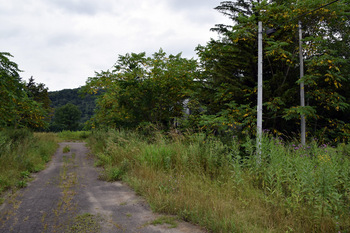 : looking down the depot on “Depot Street”
: looking down the depot on “Depot Street”
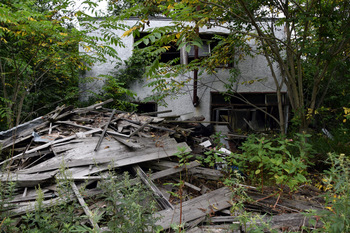 : ruin of the Murakami-Shoten mercantile in front of an abandoned structure
: ruin of the Murakami-Shoten mercantile in front of an abandoned structure
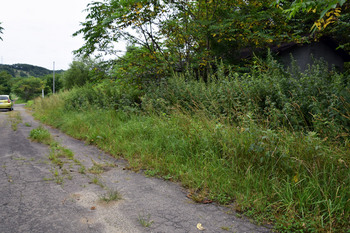 : housing almost hidden in the bush
: housing almost hidden in the bush
The town of Shimizudani was established in 1923 as an “ekitei-sho”, a kind of roadside station organized by the prefectural government, providing horses and beds for travelers, delivering mails, and selling daily necessaries[1]. The Shimizusawa Ekitei-Sho was operated by Sadaji and Mego Takeda, parents of later Kamishihoro-Cho mayor Yohzaburo Takeda[1]. It was lasted until 1936[2].
The JNR Shihoro-Sen branch and the depot were inaugurated in 1935 as a replacement for the ekitei-sho. At the same time, the town changed its name from Shimizusawa to Shimizudani. Unfortunately, however, the depot lost its agent in 1970 and was retired in 1987 due to the abandonment of the branch itself[3].
The Murakami-Shoten mercantile next to the railroad depot fulfilled the needs of the residents at its heyday: the Shimizudani Elementary School was established in 1952 near the depot, but was closed in 1975[4]. Nothing but a ruin of a store and a housing remain today at the townsite: the only survivor on the “Depot Street”, as of summer 2018, seemed the power/phone line.
* 1987 photo of the depot from “Depot Street”;
* 2004 photo of the Murakami-Shoten mercantile;
* 1977 aerial photo of the town;
Horoka【幌加】
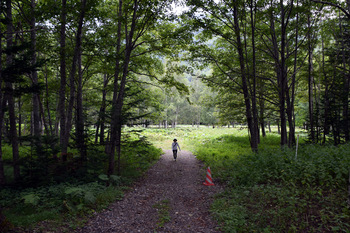 : looking down the depot on “Depot Street”
: looking down the depot on “Depot Street”
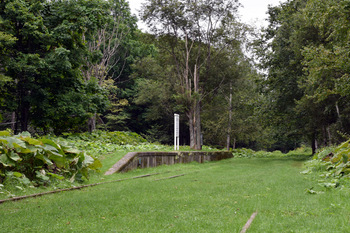 : remains of Horoka depot
: remains of Horoka depot
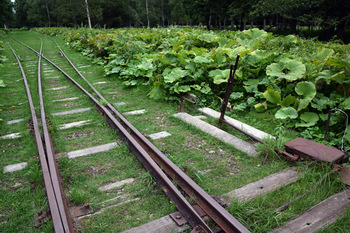 : switch left at the depot
: switch left at the depot
The town of Horoka was a logging town established in the 40’s. According to the marker at the former depot site, the town boasted of the population of 350 or 80 families in 1962. Sawmill, mercantile, gas service station, and restaurant fulfilled the needs of the residents at its heyday[5]. Unfortunately, however, the forest industry at Horoka sharply declined in the late 60’s due to the exhaustion of logs. The population of only one is registered in this town as of 2015.
The JNR Shihoro-Sen branch and the depot were inaugurated in 1939, but the depot lost its agent in 1970, closed in 1978, and retired in 1987 due to the abandonment of the branch itself[6].
Today, the townsite is returning to forest. The only remaining artifacts are the tracks and the platform of the depot: the switch still works as of summer 2018.
* 1977 photo of the depot looking from Funato-Shoten mercantile on “Depot Street”;
* photo of the same switch shown above, taken maybe in the 50’s;
* 1985 photo of the same switch shown above;
* 1977 aerial photo of the town;
Mitsumata【三股】
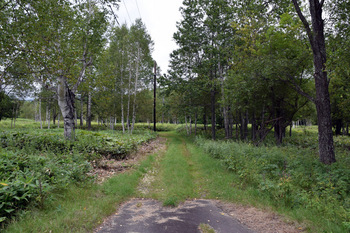 : looking down the depot on “Depot Street”
: looking down the depot on “Depot Street”
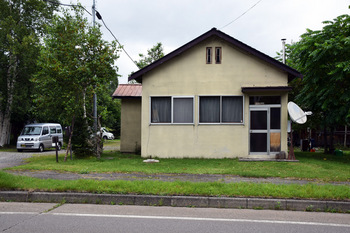 : former post office, mail carrier’s little van on the left
: former post office, mail carrier’s little van on the left
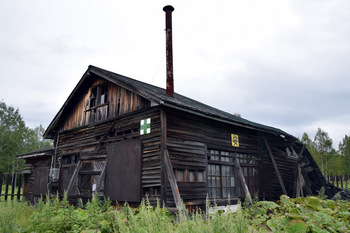 : collapsing former logging railroad blacksmith’s shop
: collapsing former logging railroad blacksmith’s shop
The town of Mitsumata was a logging town established in 1938[7]. The town boasted of the population of 1162 or 221 families in 1964. Sawmills, power station, nursery, post office, clinic, theatre, mercantile, barber, and restaurants fulfilled the needs of the residents at its heyday[8, 9]. Mitsumata Kokumin Gakkou (elementary school) was established in 1939. Unfortunately, however, the forest industry at Mitsumata declined in the 60’s due to the exhaustion of logs: in 1976, the population dropped to only 18 or 8 families and the school closed its doors. The population of only 4 or two families is registered in this town as of 2015.
Otofuke-Honryu Shinrin-Tetsudo logging railway was inaugurated in 1944 to collect logs from the valley west of the town[10]. Unfortunately, however, 5.5 miles long at its best, the 2’6” gauge railway was abandoned in 1958.
The 3’6” gauge JNR Shihoro-Sen branch and the Tokachi-Mitsumata terminal was inaugurated in 1939, but the depot was closed in 1978 and retired in 1987 due to the abandonment of the branch itself[11]. The average number of passengers a day fallen from 239 in 1965 to only 6 in 1978[1].
The only survivor on “Depot Street” seems the power line as of summer 2018. Former post office structure still survives but lost its post: mails are carried 25 miles from the town of Kami-Shihoro. Former logging railroad blacksmith’s shop built in 1950 is returning to rust[12].
* 1977 photo of the depot looking from “Depot Street”;
* 1977 aerial photo of the town;
All photos were taken at Kamishihoro-Cho, Hokkaido on Aug. 24, 2018.
[1] web archive page for history of Kamishihoro-Cho (Japanese only);
[2] Ugawa, Takao (1996). vol. 3, Ekitei-Joho;
[3] Wikipedia webpage for Shimizudani Station (Japanese only);
[4] unofficial webpage for Shimizudani Elementary School (Japanese only);
[5] 1967 map of Horoka;
[6] Wikipedia webpage for Horoka Station (Japanese only);
[7] Naruse, Kenta (2014). webpage for the history of Mitsumata (Japanese only);
[8] Yatagai, Masayoshi, (1948). Studies on Forest Colonization in Hokkaido (Ⅰ), Research Bulettins of the College Experiment Forests, Hokkaido University;
[9] 1966 map of Mitsumata;
[10] webpage for the list of historic narrow gauge railroads in Hokkaido (Japanese only);
[11] Wikipedia webpage for Tokachi-Mitsumata Station (Japanese only);
[12] Hokkaido Culture & Art Database webpage for the blacksmith’s shop (Japanese only);
少ない資料から得た情報を基に、士幌線沿線の清水谷・幌加・三股の町についてその概要を紹介する。
【清水谷】北海道河東郡上士幌町字上士幌清水谷
清水谷(旧称清水沢。鉄道開通時に既存駅名との重複を避けるため改名)の歴史は1923年に設置された駅逓所に始まる。駅逓所では馬の手配・旅行人の宿泊・郵便の授受・日用品の販売などを行ったという。開設時の取扱人・武田貞治は後の上士幌町長・武田要三郎の父である。1935年に国鉄士幌線が開通すると駅逓所は廃止になり、代わりに駅前商店街が形成された。駅前の「村上商店」は最後まで遺った店である。1952年には清水谷小学校も開校したが、町は1987年の鉄道廃止と前後して廃れたようで、現在は茂みの中に廃屋が二棟、駅前通りに相対して遺るのみである。
【幌加】北海道河東郡上士幌町字幌加
幌加の歴史は1939年の国鉄士幌線開業に始まる。1944年には蔦井與三吉率いる蔦井木材工業所が進出、1947年には上士幌営林署事業所が設置され、町は林業・木工業で栄えた。駅前には「船戸商店(電話・糠平8番)」を始めとする商店街が形成され、駅前通り突き当たりには「たこ福」食堂も開店した。しかし、1960年代後半原木の枯渇とともに急速に衰退し、現在は1987年に廃止になった駅のプラットホームおよび構内線路が遺るのみ。町は森に還りつつある。
【三股】北海道河東郡上士幌町字三股
三股の歴史は1938年に創設された青山木工場(後の明和産業)に始まる。翌1939年には国鉄士幌線が開通。同年、帯廣営林署(1947年より上士幌営林署)事業所も設けられ、1944年には音更本流森林鉄道が開業。町は林業・木工業で栄え、駅前には「ずぼらや食堂」を始めとする商店街が形成され、1944年には三股国民学校が開校した。しかし、1960年代原木の枯渇とともに衰退し、1973年には営林署事業所が撤退、翌1974年には明和産業も撤退しほぼ無人となった。現在は旧萩ヶ岡郵便局三股分室・旧音更本流森林鉄道鍛冶場・旧列車代行バス待合所および二軒の民家が遺るのみ。町はルピナスの花が咲き乱れる原野になりつつある。
Shimizudani【清水谷】
 : looking down the depot on “Depot Street”
: looking down the depot on “Depot Street” : ruin of the Murakami-Shoten mercantile in front of an abandoned structure
: ruin of the Murakami-Shoten mercantile in front of an abandoned structure : housing almost hidden in the bush
: housing almost hidden in the bushThe town of Shimizudani was established in 1923 as an “ekitei-sho”, a kind of roadside station organized by the prefectural government, providing horses and beds for travelers, delivering mails, and selling daily necessaries[1]. The Shimizusawa Ekitei-Sho was operated by Sadaji and Mego Takeda, parents of later Kamishihoro-Cho mayor Yohzaburo Takeda[1]. It was lasted until 1936[2].
The JNR Shihoro-Sen branch and the depot were inaugurated in 1935 as a replacement for the ekitei-sho. At the same time, the town changed its name from Shimizusawa to Shimizudani. Unfortunately, however, the depot lost its agent in 1970 and was retired in 1987 due to the abandonment of the branch itself[3].
The Murakami-Shoten mercantile next to the railroad depot fulfilled the needs of the residents at its heyday: the Shimizudani Elementary School was established in 1952 near the depot, but was closed in 1975[4]. Nothing but a ruin of a store and a housing remain today at the townsite: the only survivor on the “Depot Street”, as of summer 2018, seemed the power/phone line.
* 1987 photo of the depot from “Depot Street”;
* 2004 photo of the Murakami-Shoten mercantile;
* 1977 aerial photo of the town;
Horoka【幌加】
 : looking down the depot on “Depot Street”
: looking down the depot on “Depot Street” : remains of Horoka depot
: remains of Horoka depot : switch left at the depot
: switch left at the depotThe town of Horoka was a logging town established in the 40’s. According to the marker at the former depot site, the town boasted of the population of 350 or 80 families in 1962. Sawmill, mercantile, gas service station, and restaurant fulfilled the needs of the residents at its heyday[5]. Unfortunately, however, the forest industry at Horoka sharply declined in the late 60’s due to the exhaustion of logs. The population of only one is registered in this town as of 2015.
The JNR Shihoro-Sen branch and the depot were inaugurated in 1939, but the depot lost its agent in 1970, closed in 1978, and retired in 1987 due to the abandonment of the branch itself[6].
Today, the townsite is returning to forest. The only remaining artifacts are the tracks and the platform of the depot: the switch still works as of summer 2018.
* 1977 photo of the depot looking from Funato-Shoten mercantile on “Depot Street”;
* photo of the same switch shown above, taken maybe in the 50’s;
* 1985 photo of the same switch shown above;
* 1977 aerial photo of the town;
Mitsumata【三股】
 : looking down the depot on “Depot Street”
: looking down the depot on “Depot Street” : former post office, mail carrier’s little van on the left
: former post office, mail carrier’s little van on the left : collapsing former logging railroad blacksmith’s shop
: collapsing former logging railroad blacksmith’s shopThe town of Mitsumata was a logging town established in 1938[7]. The town boasted of the population of 1162 or 221 families in 1964. Sawmills, power station, nursery, post office, clinic, theatre, mercantile, barber, and restaurants fulfilled the needs of the residents at its heyday[8, 9]. Mitsumata Kokumin Gakkou (elementary school) was established in 1939. Unfortunately, however, the forest industry at Mitsumata declined in the 60’s due to the exhaustion of logs: in 1976, the population dropped to only 18 or 8 families and the school closed its doors. The population of only 4 or two families is registered in this town as of 2015.
Otofuke-Honryu Shinrin-Tetsudo logging railway was inaugurated in 1944 to collect logs from the valley west of the town[10]. Unfortunately, however, 5.5 miles long at its best, the 2’6” gauge railway was abandoned in 1958.
The 3’6” gauge JNR Shihoro-Sen branch and the Tokachi-Mitsumata terminal was inaugurated in 1939, but the depot was closed in 1978 and retired in 1987 due to the abandonment of the branch itself[11]. The average number of passengers a day fallen from 239 in 1965 to only 6 in 1978[1].
The only survivor on “Depot Street” seems the power line as of summer 2018. Former post office structure still survives but lost its post: mails are carried 25 miles from the town of Kami-Shihoro. Former logging railroad blacksmith’s shop built in 1950 is returning to rust[12].
* 1977 photo of the depot looking from “Depot Street”;
* 1977 aerial photo of the town;
All photos were taken at Kamishihoro-Cho, Hokkaido on Aug. 24, 2018.
[1] web archive page for history of Kamishihoro-Cho (Japanese only);
[2] Ugawa, Takao (1996). vol. 3, Ekitei-Joho;
[3] Wikipedia webpage for Shimizudani Station (Japanese only);
[4] unofficial webpage for Shimizudani Elementary School (Japanese only);
[5] 1967 map of Horoka;
[6] Wikipedia webpage for Horoka Station (Japanese only);
[7] Naruse, Kenta (2014). webpage for the history of Mitsumata (Japanese only);
[8] Yatagai, Masayoshi, (1948). Studies on Forest Colonization in Hokkaido (Ⅰ), Research Bulettins of the College Experiment Forests, Hokkaido University;
[9] 1966 map of Mitsumata;
[10] webpage for the list of historic narrow gauge railroads in Hokkaido (Japanese only);
[11] Wikipedia webpage for Tokachi-Mitsumata Station (Japanese only);
[12] Hokkaido Culture & Art Database webpage for the blacksmith’s shop (Japanese only);
少ない資料から得た情報を基に、士幌線沿線の清水谷・幌加・三股の町についてその概要を紹介する。
【清水谷】北海道河東郡上士幌町字上士幌清水谷
清水谷(旧称清水沢。鉄道開通時に既存駅名との重複を避けるため改名)の歴史は1923年に設置された駅逓所に始まる。駅逓所では馬の手配・旅行人の宿泊・郵便の授受・日用品の販売などを行ったという。開設時の取扱人・武田貞治は後の上士幌町長・武田要三郎の父である。1935年に国鉄士幌線が開通すると駅逓所は廃止になり、代わりに駅前商店街が形成された。駅前の「村上商店」は最後まで遺った店である。1952年には清水谷小学校も開校したが、町は1987年の鉄道廃止と前後して廃れたようで、現在は茂みの中に廃屋が二棟、駅前通りに相対して遺るのみである。
【幌加】北海道河東郡上士幌町字幌加
幌加の歴史は1939年の国鉄士幌線開業に始まる。1944年には蔦井與三吉率いる蔦井木材工業所が進出、1947年には上士幌営林署事業所が設置され、町は林業・木工業で栄えた。駅前には「船戸商店(電話・糠平8番)」を始めとする商店街が形成され、駅前通り突き当たりには「たこ福」食堂も開店した。しかし、1960年代後半原木の枯渇とともに急速に衰退し、現在は1987年に廃止になった駅のプラットホームおよび構内線路が遺るのみ。町は森に還りつつある。
【三股】北海道河東郡上士幌町字三股
三股の歴史は1938年に創設された青山木工場(後の明和産業)に始まる。翌1939年には国鉄士幌線が開通。同年、帯廣営林署(1947年より上士幌営林署)事業所も設けられ、1944年には音更本流森林鉄道が開業。町は林業・木工業で栄え、駅前には「ずぼらや食堂」を始めとする商店街が形成され、1944年には三股国民学校が開校した。しかし、1960年代原木の枯渇とともに衰退し、1973年には営林署事業所が撤退、翌1974年には明和産業も撤退しほぼ無人となった。現在は旧萩ヶ岡郵便局三股分室・旧音更本流森林鉄道鍛冶場・旧列車代行バス待合所および二軒の民家が遺るのみ。町はルピナスの花が咲き乱れる原野になりつつある。
2018-10-05 09:00
コメント(0)




コメント 0